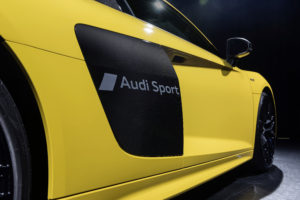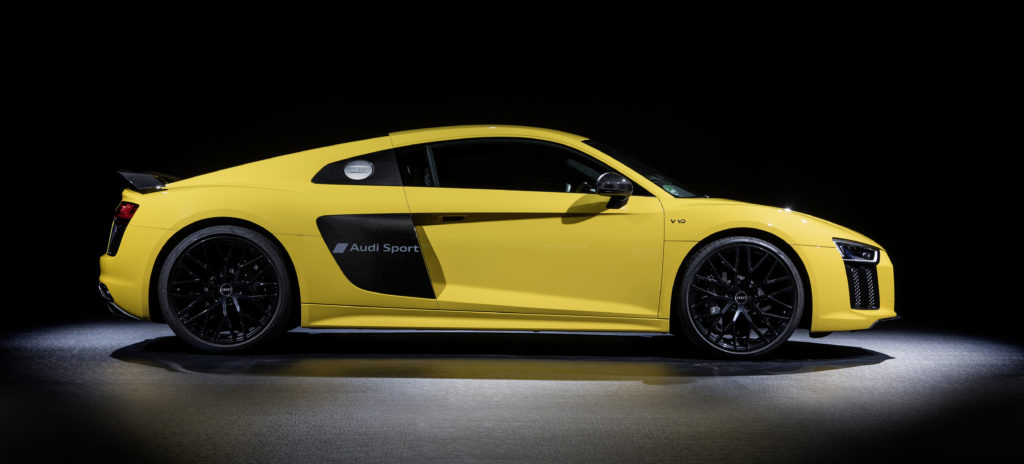
Audi can etch custom matte designs in car paint, plans to expand option beyond R8 supercar
By onAnnouncements | Repair Operations | Technology
It’s almost like high-tech keying: Audi has developed a method of partially matting a vehicle part, allowing owners to etch custom designs into a car’s paint job.
Right now, Audi will only offer the option to the side blades of R8 supercars, which start at $162,900 and are made of aluminum and carbon fiber. But other Audi repairers could eventually encounter the paint technique.
“It is planned to extend the offer to other models in the future,” Audi wrote in a news release.
Audi says it’ll produce any symbol that doesn’t infringe “third-party rights,” which probably means no trademarked or copyrighted imagery, so each Audi can be unique.
“The method of partial matting is an excellent example of the flexibility of our production,” Audi production management board member Dr. Hubert Waltl said in a statement. “Being able to implement individualization in normal series production is one of the aims of our smart factory,” stated Prof.
According to Audi, the process happens after the vehicle is painted:
Painting an automobile consists of – in addition to the cathodic dip coating to protect against corrosion – at least three further coats: filler, base coat and the transparent lacquer as the top protective coat. With the newly developed process, a template of the desired pattern is first placed on the component. A blasting system then sprays a special powder onto the surface, which roughens the clear lacquer to a depth of just a few thousandths of a millimeter – less than a tenth of the thickness of a human hair. This creates the effect of a (matte) and homogeneous pattern.
Audi says it can design any part up to a meter square.

“With this process, we modify the brilliance of the paintwork and the intensity of its sheen. Light hitting the surface is then reflected diffusely by the individualized surface areas. This makes it appear matt,” project manager Dr. Erhard Brandl said in a statement.
“This form of individualization is weather resistant, unlike conventional lettering and stickers, and it has a much more high-quality appearance,” Audi production section head Mirko Endres said in a statement.
An Audi spokeswoman said she couldn’t address what the etching process would mean for collision repair or refinishing.
“At this time, we can’t speak to the paint etching process at it would relate to damages or repairs,” R8 product communication specialist Amanda Koons wrote in an email. “We may have more information as this rolls out to production vehicles.”
As noted above, the R8 is mostly carbon fiber and aluminum. Audi says 13 percent of the regular R8’s “Audi Space Frame” is carbon fiber, and a news release for the R8 Spyder describes 80 percent of that body-in-white as aluminum. Carbon fiber elements can also include the front lip spoiler, sideblades, diffuser, and rear spoiler.
Audi also describes an aluminum “lattice structure that engineers used in order to incorporate specific reinforcements into the sills, A-posts and windshield frame” of the Spyder.
Koons also said the Spyder uses a lot of adhesive, which holds more or less true as well for the general R8 as well.
“The R8 Spyder embodies the Audi brand’s expertise in lightweight design through the application of the new ASF,” Koons wrote. “Manufacturing occurs in a special facility to ensure the aluminum and carbon fiber elements come together to create the high-quality ASF. On the Spyder, the ASF is approximately 80% aluminum, 12% carbon fiber and 8% adhesive and fasteners.”
“The materials breakdown is very similar for the R8 V10 Coupe – with the Coupe having a slightly higher percentage of carbon fiber than the Spyder,” she wrote in a subsequent email.
Audi reported it sold nearly 3,000 R8s worldwide in 2016.
More information:
“Audi etches symbols into car paint”
Audi, Jan. 24, 2017
Audi, Jan. 20, 2016
“Audi of America drops the top on the all-new 2017 R8 V10 Spyder”
Audi, Jan. 25, 2017
Featured image: Audi’s new partial paint matte technique produced the “Audi Sport” design on this R8. (Provided by Audi)
